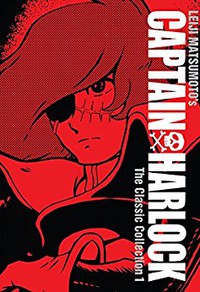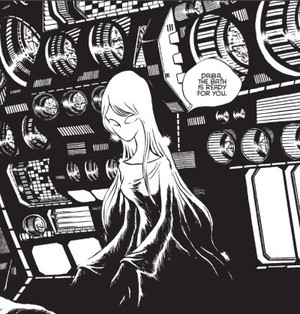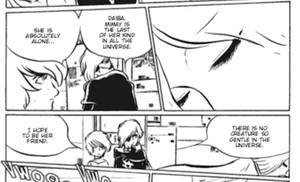The Spring 2018 Manga Guide
Captain Harlock Classic Collection
What's It About?
 In the far-distant future, the Earth is failing as its oceans vanish. Humanity begins to take to a different sea, the vast reaches of outer space, where they encounter not only new places to explore, but races and beings they'd never even dreamed of.
In the far-distant future, the Earth is failing as its oceans vanish. Humanity begins to take to a different sea, the vast reaches of outer space, where they encounter not only new places to explore, but races and beings they'd never even dreamed of. Harlock the space pirate is among the best known of these captains in the new age of exploration, an enigmatic man who, along with his motley crew, voyages on the pirate vessel Arcadia. When a strange orb bearing inscriptions similar to Mayan hieroglyphs crashes to Earth, Harlock is paying close attention – and when it turns out to be a harbinger of the race of space women known as Mazons, the women who burn like paper, he knows he has to intervene, especially since Earth's singular government doesn't appear interested in doing so.
While he's investigating, he picks up teenager Tadashi Daiba, the son of his old friend Dr. Daiba, and the boy finds a new home aboard the pirate ship. Alongside Harlock and his trusted crewmates, Daiba begins to learn the truth about the women who killed his father – and that maybe it isn't so much that they're invading Earth as that they're Coming Home. Captain Harlock: The Classic Collection is by Leiji Matsumoto and will be published in June by Seven Seas, selling for $24.99.
Is It Worth Reading?
 Rebecca Silverman
Rebecca SilvermanRating:
There's something about a Leiji Matsumoto space opera that just makes me want to wax poetic. They capture the excitement of space travel and the seemingly endless possibilities that marked the early days of space exploration, melding science fiction with the older style of adventure narrative made popular by books like Treasure Island. Captain Harlock isn't as beautiful as Galaxy Express 999 or Queen Emeraldas in terms of its look at the emotions driving people to sail the sea of stars, but it skillfully blends its high tech base with history and mythology, making it fascinating in its own right.
If you've already read the modern reboot of the series, Captain Harlock: Dimensional Voyage, you'll already be familiar with the basic plot: alien women named Mazons are invading an Earth that doesn't appear to care, so it's up to Harlock and the orphaned son of his old pal Dr. Daiba to figure out what to do. This a case where the folk wisdom that the original is always better really does hold true – Matsumoto has a lighter touch than his later imitator, and there are threads of humor here that help the book from feeling too dense or depressing. Harlock himself is also less of a dark character; yes, he laments the loss of his best friend (no flashbacks here, folks), but it doesn't consume him. The same holds true for Mimay: where in the reboot the sum total of her character is “I love Harlock and would die for him,” here she's more of an actual character rather than a bad stereotype. In both cases it's easy to see how the newer versions of the characters were arrived at, but they, and the rest of the cast, are much more engaging in Matsumoto's original forms.
As you may have noticed, the villains of the piece, the Mazons or “women who burn like paper,” have a distinct resemblance to the Amazons of mythology. That's entirely on purpose, and Matsumoto isn't trying to be cute with his name for the warrior women either. As the story goes on, it becomes increasingly clear that Matsumoto has done his research and is playing off of the fact that myths of tribes of warrior women did in fact exist around the world and that explorers of South America made up stories of having found the Amazons in what we now call “the Amazon.” (The only officially documented “Amazons” are the warrior women of Dahomey [Republic of Benin] in Western Africa.) The sites where Mazon activity is discovered and the continued use of hieroglyphs and ancient structures like pyramids and observatories make excellent use of the combination of history and mythology surrounding the Amazons, and even the name of their ruler sounds a bit like a reworking of Latoreia, an Amazon warrior from Greek mythology.
Because the series does hail from the mid-1970s, there are outdated elements, such as the use of repetition and science fiction jargon that firmly dates the story, as well as astounding amounts of dials in the technology. But the story itself is good enough that even if you're not a fan of older manga this is interesting, and Matsumoto's art holds up well despite clearly being from an older time. There's a reason why he's the king of the space opera, and this extra-long volume does a good job showing us why.
 Amy McNulty
Amy McNultyRating:
Captain Harlock is an iconic sci fi series—not just in Japan, but (to a lesser degree) in many countries throughout the world. To be that, it had to be one of the earliest and most successful examples of sci-fi manga. However, because of that, there's no helping this Classic Collection feeling dated. Pre-existing fans will likely relish getting their hands on the earliest examples of the famed space pirate's adventures. However, as an introduction to the franchise as a whole, it feels a touch sterile and lacking. Perhaps a fan of the classic sci-fi genre would think differently, but for readers who rarely wade into science fiction from four decades ago, the narrative drags at times and feels too clinical at others. Attempts are made at humanizing the cast, such as Harlock's frequent references to a beloved, fallen best friend and alien Mimay's steadfast devotion to serving Harlock's goals. However, at least within the context of this initial adventure, not enough time is spent developing the individuals who populate the Arcadia, nor even its newest recruit, who is motivated entirely by the loss of his father and the slow alien assault on Earth. It is timeless, though, how the leaders of Earth focus on their own interests—lamenting the loss of golf courses and opera houses—and ignore the giant orb that threatens to destroy humankind. Harlock's crew may skirt the law, but they at least know what's more important, and they'll wax poetic about all the universe's grander designs.
Matsumoto's art is one-of-a-kind and instantly recognizable, though it is frustrating that he seems to have three default character designs he builds off of: handsome man; beautiful, willowy woman; and comedic chibi sidekick. The “beautiful” people in particular are too similar, down to the same kinds of hairstyles. However, the spaceships are top-notch and highly detailed, and there's always enough going on in the backgrounds to bring this futuristic setting to life.
There are many long-time manga fans who will no doubt want Captain Harlock: The Classic Collection volume 1 on their shelves, especially since there's a hardcover edition available. Though I can't speak to the presentation of the hardcover since I had a digital review copy, I did find the few color pages distinctive with everything colored in shades of brown and orange, so I imagine they look good in print. This first volume is slow for readers who aren't already Captain Harlock fans, but it does have some memorable moments that might create new fans of the franchise who will be eager to keep reading.
discuss this in the forum (28 posts) |
this article has been modified since it was originally posted; see change history
back to The Spring 2018 Manga Guide
Feature homepage / archives